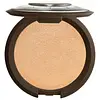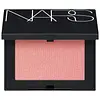What's inside
What's inside
 Key Ingredients
Key Ingredients

 Benefits
Benefits

 Concerns
Concerns

 Ingredients Side-by-side
Ingredients Side-by-side

Talc
AbrasiveCaprylic/Capric Triglyceride
MaskingIsostearyl Alcohol
EmollientPetrolatum
EmollientSilica
AbrasiveBoron Nitride
AbsorbentNylon-12
Hdi/Trimethylol Hexyllactone Crosspolymer
Dimethicone
EmollientParaffin
PerfumingMicrocrystalline Wax
Emulsion StabilisingPolyethylene
AbrasiveMagnesium Stearate
Cosmetic ColorantSorbitan Sesquioleate
EmulsifyingCalcium Sodium Borosilicate
Synthetic Fluorphlogopite
Triethoxycaprylylsilane
Calcium Aluminum Borosilicate
Tin Oxide
AbrasiveTetrasodium EDTA
Chlorphenesin
AntimicrobialPotassium Sorbate
PreservativeMica
Cosmetic ColorantCI 77891
Cosmetic ColorantCI 77491
Cosmetic ColorantCI 77492
Cosmetic ColorantCI 77499
Cosmetic ColorantCI 77000
Cosmetic ColorantCI 42090
Cosmetic ColorantCI 77400
Cosmetic ColorantCI 77163
Cosmetic ColorantCI 75470
Cosmetic ColorantCI 77289
Cosmetic ColorantCI 77288
Cosmetic ColorantCI 77510
Cosmetic ColorantCI 77742
Cosmetic ColorantCI 77007
Cosmetic ColorantCI 19140
Cosmetic ColorantTalc, Caprylic/Capric Triglyceride, Isostearyl Alcohol, Petrolatum, Silica, Boron Nitride, Nylon-12, Hdi/Trimethylol Hexyllactone Crosspolymer, Dimethicone, Paraffin, Microcrystalline Wax, Polyethylene, Magnesium Stearate, Sorbitan Sesquioleate, Calcium Sodium Borosilicate, Synthetic Fluorphlogopite, Triethoxycaprylylsilane, Calcium Aluminum Borosilicate, Tin Oxide, Tetrasodium EDTA, Chlorphenesin, Potassium Sorbate, Mica, CI 77891, CI 77491, CI 77492, CI 77499, CI 77000, CI 42090, CI 77400, CI 77163, CI 75470, CI 77289, CI 77288, CI 77510, CI 77742, CI 77007, CI 19140
Synthetic Fluorphlogopite
Mica
Cosmetic ColorantZinc Stearate
Cosmetic ColorantMagnesium Myristate
Octyldodecyl Stearoyl Stearate
EmollientCaprylic/Capric Triglyceride
MaskingTin Oxide
Abrasive1,2-Hexanediol
Skin ConditioningCaprylyl Glycol
EmollientAluminum Hydroxide
EmollientKaolin
AbrasiveCI 77120
Cosmetic ColorantCI 77163
Cosmetic ColorantIron Oxides
CI 45410
Cosmetic ColorantCI 73360
Cosmetic ColorantCI 17200
Cosmetic ColorantCI 15850
Cosmetic ColorantCI 77891
Cosmetic Colorant
 Reviews
Reviews

Ingredients Explained
These ingredients are found in both products.
Ingredients higher up in an ingredient list are typically present in a larger amount.
This ingredient is an emollient, solvent, and texture enhancer. It is considered a skin-softener by helping the skin prevent moisture loss.
It helps thicken a product's formula and makes it easier to spread by dissolving clumping compounds.
Caprylic Triglyceride is made by combining glycerin with coconut oil, forming a clear liquid.
While there is an assumption Caprylic Triglyceride can clog pores due to it being derived from coconut oil, there is no research supporting this.
Learn more about Caprylic/Capric TriglycerideThis synthetic powder is used to add a pearly/white color in cosmetics.
Ci 77891 is a white pigment from Titanium dioxide. It is naturally found in minerals such as rutile and ilmenite.
It's main function is to add a white color to cosmetics. It can also be mixed with other colors to create different shades.
Ci 77891 is commonly found in sunscreens due to its ability to block UV rays.
Learn more about CI 77891Mica is a naturally occurring mineral used to add shimmer and color in cosmetics. It can also help improve the texture of a product or give it an opaque, white/silver color.
Serecite is the name for very fine but ragged grains of mica.
This ingredient is often coated with metal oxides like titanium dioxide. Trace amounts of heavy metals may be found in mica, but these metals are not harmful in our personal products.
Mica has been used since prehistoric times throughout the world. Ancient Egyptian, Indian, Greek, Roman, Aztec, and Chinese civilizations have used mica.
Learn more about MicaSynthetic Fluorphlogopite is the synthethic version of mica. It consists of fluorine, aluminum and silicate.
Synthetic Fluorphlogopite is used to add volume to products.
It is considered non-irritating on the skin.
Learn more about Synthetic FluorphlogopiteTin Oxide is an inorganic oxide used to add opacity and volume to a product. In nature, it is already found in mineral form. The main ore of tin is an opaque and shiny mineral called casseterite.
Tin Oxide helps remove translucency in a product, or make it more opaque. Besides adding opacity, tin oxide is used for bulking to add volume.